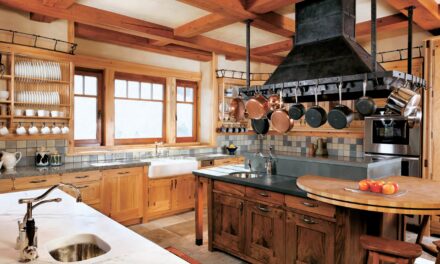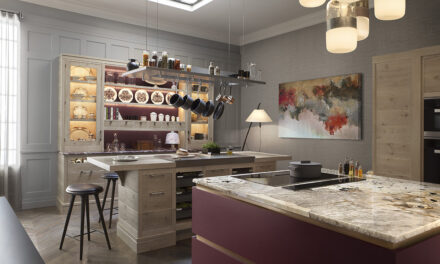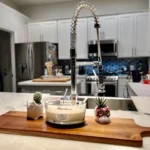Designing a kitchen for a container home presents a unique opportunity to blend minimalist living with modern functionality. With limited space but endless creative potential, container home kitchen challenge you to think outside the box—literally. Whether you’re a fan of sleek, industrial aesthetics or you prefer a cozy, rustic vibe, the compact layout of a container kitchen encourages smart design decisions that maximize every square inch.
From multi-purpose cabinetry to energy-efficient appliances, the key to a successful container home is all about balance. It’s about creating a space that feels open and inviting, despite the small footprint. By incorporating clever storage solutions and innovative layouts, you can craft a kitchen that not only looks great but also meets your everyday cooking needs.
Additionally, sustainable living is often at the heart of container homes, and your kitchen can reflect this ethos with eco-friendly materials and energy-saving appliances. Whether you’re building from scratch or remodeling an existing container, a well-planned kitchen can enhance both the aesthetic and functionality of your home, making the most of the compact yet versatile container living experience.
Tiny Space, Big Impact: Optimizing Container Home Kitchen
In this detailed guide, we’ll explore how to make the most of your kitchen space, the best materials to use, efficient storage solutions, and tips on integrating sustainable, energy-efficient appliances. From layout designs to lighting choices, you’ll find everything you need to build or remodel the perfect container home kitchen. Let’s dive into how you can turn a tiny space into a kitchen that makes a big impact. For more information visit here
Table of Contents
Planning the Perfect Layout: Compact but Functional
One of the first things to consider in optimizing a container home kitchen is the layout. With a container’s narrow dimensions, the layout will play a crucial role in how functional and comfortable your kitchen is. Common layouts for container home kitchens include:
- Galley Layout: A galley kitchen is ideal for narrow spaces. It involves two parallel countertops with a walkway between them. This layout maximizes both storage and counter space while keeping everything within arm’s reach.
- L-Shaped Layout: This is a popular layout for container homes as it utilizes two adjacent walls, leaving the other sides open, which can create an illusion of more space.
- U-Shaped Layout: If you have more room or are working with a larger container home, a U-shaped layout is an excellent choice for maximizing counter space and storage. However, it can make the kitchen feel more enclosed.
Tip: When planning your layout, consider the work triangle—an efficient kitchen design concept that places the sink, stove, and refrigerator in a triangle configuration. This arrangement minimizes movement and maximizes efficiency.
Selecting Space-Saving Appliances
In a container home kitchen, size matters—especially when it comes to appliances. Standard kitchen appliances can take up too much space, so opting for compact, multifunctional, and energy-efficient models is key.
- Smaller Refrigerators: Look for under-counter refrigerators or narrow, tall fridges that save space without sacrificing capacity.
- Combination Microwave and Oven: These combo units save space by serving dual functions in one appliance.
- Two-Burner Cooktops: If you don’t require a full-sized stove, a two-burner electric or gas cooktop is a smart choice.
- Drawer Dishwashers: These dishwashers fit seamlessly into your cabinetry and take up less space than full-sized models.
Tip: Consider appliances that are proportionate to the scale of your kitchen. Overly large appliances can make the space feel cramped.
Maximizing Storage Solutions
Storage is perhaps the biggest challenge in a container home kitchen, but it can be solved with some creativity. To make the most of every square inch, consider the following solutions:
- Vertical Storage: Utilize the height of your kitchen by installing tall cabinets that reach the ceiling. Open shelving is another great way to store items vertically without making the space feel enclosed.
- Pull-Out Pantries: Slim pull-out pantries can be installed in small gaps between appliances or counters and offer a convenient way to store non-perishable items.
- Magnetic Strips and Hooks: Attach magnetic strips to your walls to store knives and metal container home kitchen tools, or use hooks under cabinets for mugs and utensils.
- Rollout Shelves and Drawers: Installing pull-out shelves inside your lower cabinets allows you to access everything without crawling into the cabinets.
Tip: Choose storage solutions that minimize clutter and make the space feel more open. Transparent jars, wire baskets, and well-organized cabinets can help create a sense of order in a small kitchen.
Choosing the Right Materials for a Small Kitchen
The materials you choose for your kitchen surfaces, cabinets, and countertops can make a significant difference in how your container home kitchen looks and feels. Durable, easy-to-clean materials are ideal for small spaces where every surface will be used frequently.
- Countertops: Quartz, stainless steel, and butcher block are all excellent choices. Quartz is low-maintenance and comes in various colors, while stainless steel offers an industrial, sleek look. Butcher block adds warmth and a rustic touch.
- Cabinetry: Opt for light-colored cabinets that make the space feel larger. Glossy finishes can reflect light and give the illusion of more space. If you prefer darker cabinetry, pair it with light countertops or walls to prevent the kitchen from feeling too confined.
- Backsplashes: Subway tiles are a timeless choice for small kitchens. For a modern look, you could use glass or metal backsplashes that reflect light and give the space a more expansive feel.
Tip: When choosing materials, think about the overall vibe you want for your container home kitchen. Industrial, rustic, modern, or minimalist—each material can shape the kitchen’s style and atmosphere.
Smart Lighting for Small Spaces
Lighting plays a crucial role in making a small space feel larger and more inviting. The right lighting can enhance the openness of your container home kitchen while also providing functionality.
- Under-Cabinet Lighting: These lights are perfect for illuminating countertops without taking up valuable space. They also reduce shadows and make the kitchen feel more open.
- Pendant Lights: If you have a breakfast bar or kitchen island, pendant lights can provide focused task lighting while adding an element of design to your kitchen.
- Skylights or Windows: Natural light is your best friend in a container home. If possible, install skylights or large windows to flood the space with light, making it feel larger and more open.
Tip: Combine natural light with layered lighting. Ambient, task, and accent lighting work together to create a well-lit, welcoming space.
Eco-Friendly and Sustainable Kitchen Choices
container home kitchen are often associated with sustainability, so it’s essential to carry that eco-conscious mindset into your kitchen design. Here are some ways to create an eco-friendly kitchen:
- Energy-Efficient Appliances: Look for ENERGY STAR-rated appliances, which use less energy and water, reducing your carbon footprint.
- Sustainable Materials: Opt for eco-friendly materials like bamboo for flooring, recycled glass countertops, or reclaimed wood cabinetry.
- Low-VOC Paints: Use paints with low volatile organic compounds (VOCs) to minimize indoor air pollution and make your container home kitchen healthier.
- Water-Saving Fixtures: Install water-efficient faucets and dishwashers to reduce water consumption.
Tip: Sustainability isn’t just about materials—consider energy consumption, waste reduction, and the overall environmental impact of your kitchen design.
Incorporating Multipurpose Features
In small spaces, multipurpose items are lifesavers. Incorporate furniture and fixtures that serve more than one function:
- Fold-Down Tables: If you don’t have space for a full dining area, a fold-down table attached to the wall can be pulled down for meals and stowed away when not in use.
- Movable Kitchen Islands: A kitchen island on wheels provides extra counter space when needed and can be rolled away when you need more floor space.
- Convertible Counters: Some countertops can double as cutting boards or hide pull-out drawers underneath for additional storage.
Tip: Choose furniture and features that can be easily adapted to your changing needs. Flexibility is essential in a container home kitchen.
Personalizing Your Kitchen: Design and Décor Tips
Finally, while functionality is key, don’t forget to infuse your personality into your container home kitchen. Here are some ways to add character:
- Color Palette: Light colors tend to open up small spaces, but don’t shy away from bold accents. A vibrant backsplash or colorful accessories can add personality.
- Plants: Bring nature indoors with small potted herbs or succulents. Vertical gardens can be a great way to introduce greenery without taking up counter space.
- Artwork and Textiles: Small pieces of art, patterned rugs, or unique dish towels can give your kitchen a personal touch and make it feel homier.
Tip: Keep your décor minimal to avoid clutter. Opt for functional decorative items, such as hanging pots and pans or stylish storage jars.
Maximizing Airflow and Ventilation
In a small container home kitchen, proper airflow is critical to prevent heat and odors from overwhelming the space. Ensuring good ventilation not only enhances comfort but also extends the lifespan of your kitchen materials by reducing moisture build-up.
- Range Hoods: Even in a compact kitchen, installing a range hood above your stove is essential. It helps in removing smoke, odors, and excess heat. Opt for slim, low-profile models designed for small spaces.
- Cross Ventilation: If possible, incorporate windows or vents on opposite sides of the container to encourage cross ventilation. This will help keep your kitchen fresh, especially after cooking.
- Exhaust Fans: If windows are limited, an exhaust fan can be an efficient alternative to remove stale air and excess moisture. Position it strategically to draw air out of the kitchen.
Tip: Proper ventilation is essential in maintaining air quality, especially in a compact and potentially enclosed environment like a container home. Fresh air flow will also help regulate indoor temperature, keeping the kitchen cooler.
Creative Flooring Ideas for Small Kitchens
Flooring is often overlooked, but it plays a significant role in tying the entire space together. In a container home kitchen, you’ll want to choose durable, easy-to-clean flooring that can withstand the wear and tear of cooking and high foot traffic. Here are some options:
- Vinyl: Affordable, waterproof, and easy to install, vinyl flooring is a great option for container home kitchens. Modern vinyl designs can mimic hardwood or tile, offering style without sacrificing practicality.
- Cork: Cork is an eco-friendly, soft flooring material that adds warmth to a kitchen. It’s also naturally resistant to moisture, making it a good choice for kitchens in container homes.
- Tile: Ceramic or porcelain tiles are durable and easy to clean, though they can be cold underfoot. If you prefer a tiled floor, consider adding underfloor heating to maintain a cozy temperature.
- Bamboo: Another sustainable option, bamboo is both durable and environmentally friendly. It provides a modern, natural look and is a great fit for container home kitchens focused on sustainability.
Tip: Light-colored flooring can help make a small kitchen feel more open, while patterned floors can add a sense of depth and style without overwhelming the space.
Incorporating Smart Home Technology
Incorporating smart home technology into your container home kitchen can elevate both convenience and efficiency. With space at a premium, automating certain aspects of the kitchen can help you make the most of your setup:
- Smart Lighting: Use smart bulbs that allow you to control lighting intensity and color via your phone. This can be especially useful for mood lighting or task lighting without the need for manual switches.
- Smart Appliances: Invest in appliances that connect to your home’s Wi-Fi and allow for remote operation. Smart refrigerators, ovens, and dishwashers can provide additional functionality like monitoring your grocery supply or preheating remotely.
- Voice-Controlled Assistants: Devices like Amazon Alexa or Google Assistant can help you control appliances, set timers, and even read recipes without having to touch anything, keeping your hands free while cooking.
Tip: When working with limited space, every gadget should add real value to your daily life. Avoid cluttering your space with unnecessary technology and focus on practical applications that improve the functionality of your kitchen.
Budgeting and Prioritizing: What to Invest In
When optimizing a container home kitchen, it’s essential to set a budget and prioritize which elements are worth investing in. With the variety of options available, focusing on quality and durability is key.
- Invest in Quality Appliances: Compact, energy-efficient appliances may cost more upfront, but their long-term savings in energy bills and extended lifespan make them a worthwhile investment.
- Splurge on Countertops: Since you’ll likely have limited counter space, choosing a high-quality material like quartz or butcher block ensures longevity and an attractive finish.
- Cabinetry and Storage Solutions: Custom-built cabinets or shelves tailored to your specific kitchen dimensions can help you maximize every inch of storage. Though they may be more expensive, they offer functionality and a cleaner aesthetic.
- Save on Décor: When it comes to decorations and accessories, you don’t need to splurge. Simple, functional items can provide the style you’re after without blowing your budget.
Tip: Create a list of must-haves and nice-to-haves. Focus your budget on the elements that will have the most significant impact on your kitchen’s functionality, and consider more affordable alternatives for the rest.
Maintenance Tips for a Container Home Kitchen
To keep your kitchen looking and functioning at its best, it’s important to establish regular maintenance routines. The compact nature of a container home kitchen means that messes can pile up quickly, and small problems, like leaks or scratches, can become noticeable.
- Regular Cleaning: Establish a cleaning routine that involves wiping down countertops and surfaces daily, as well as cleaning appliances, floors, and cabinets weekly. Compact kitchens tend to show dirt faster, so a consistent schedule helps maintain a fresh appearance.
- Check for Moisture Buildup: container home kitchen are prone to moisture issues, so it’s vital to keep an eye on ventilation and watch for condensation on windows or walls. Address any moisture problems promptly to avoid mold and mildew growth.
- Cabinet and Appliance Care: Periodically check hinges, handles, and drawer mechanisms to ensure everything is in working order. Clean your appliances inside and out to keep them running efficiently and looking like new.
- Inspect Plumbing: In a small kitchen, leaks can cause significant damage quickly. Regularly check under sinks and around faucets for any signs of drips or leaks.
Tip: Stay proactive with maintenance tasks to prevent small issues from becoming bigger, more costly problems. Simple upkeep will extend the life of your kitchen and keep it looking fresh and functional.
Future-Proofing Your Kitchen
As container home kitchen continue to evolve, future-proofing your kitchen design can ensure it remains functional and stylish for years to come. Incorporating flexible design elements and considering potential technological advancements can help you stay ahead.
- Modular Components: Choose modular cabinetry and shelving that can be easily reconfigured as your needs change. This allows for adaptability and future expansion if necessary.
- Upgradable Appliances: When selecting appliances, think about whether they can be easily updated or replaced without needing to modify the entire kitchen. Opt for smart appliances that are compatible with updates or expansions in home automation systems.
- Universal Design: Consider incorporating universal design principles that make your kitchen accessible to people of all ages and abilities. Features like pull-down shelves, lever-handled faucets, and open floor space can ensure your kitchen remains usable for everyone.
Tip: Flexibility is key when future-proofing a small kitchen. Design elements that allow for growth or upgrades ensure that your container home kitchen continues to meet your needs, no matter how they change over time.
Conclusion
Designing a container home kitchen that is both stylish and functional may seem challenging, but with the right approach, you can maximize every inch of space. From carefully planning your layout and selecting space-saving appliances to integrating smart technology and eco-friendly materials, there are countless ways to optimize your home kitchen. By focusing on efficiency, storage, and aesthetics, you can create a kitchen that truly makes a big impact, no matter how small the space may be.
Remember, a successful home kitchen is not about sacrificing comfort or style. It’s about embracing innovation, creativity, and thoughtful design to craft a space that feels both expansive and practical. Whether you’re building from scratch or remodeling, the possibilities for optimizing your container home are endless—proving that even in a tiny space, big things can happen.










